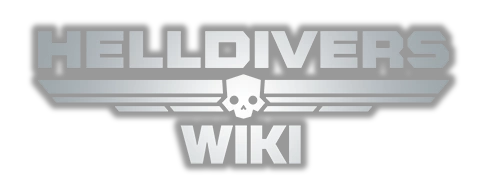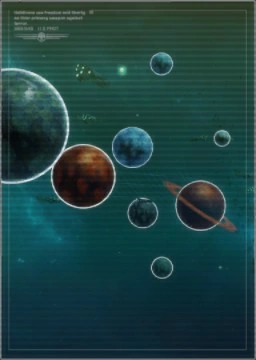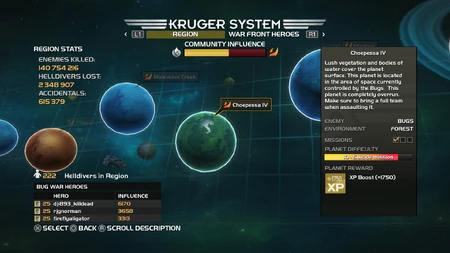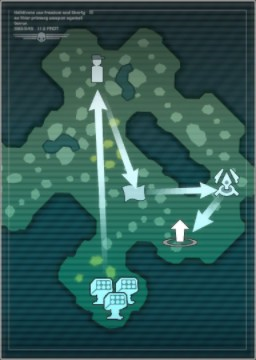Overview[ | ]
Selecting a planet through the planet selection console is the means by which Helldivers players choose the difficulty of their next mission(s). Players must first use the Galactic Campaign map to decide which enemy to fight (Bugs, Cyborgs or the Illuminate).
If the selected region's sector is not the homeworld sector (the last sector available in the region), they will then be presented with 15-17 different planets which are currently occupied by the enemy. Twelve of them, forming a horizontal chain, span the twelve standard difficulties (planets with identically-formatted difficulties in the following list pull from the same general pool of Stratagems when determining their planet reward):
- Dive in the Park
- Very Easy- [Introduces Light Enemy Warriors]
- Easy
- Medium - [Introduces Medium Sized Enemies]
- Challenging - [Introduces Heavy Enemies]
- Very Challenging - [Increases Number of enemies]
- Hard
- Very Hard - [Introduces Elite Enemies]
- Hard as Hell - [Increases Number of Elites]
- Suicide Mission
- Impossible - [Reduces amount of light enemies]
- Helldive - [Highest difficulty before the 2018 A New Hell free content update]
- An Exercise in Futility - [Introduces new enemy units]
- The Definition of Insanity - [Reduces amount of light enemies]
- The Inner Circle of Hell - [Reduces amount of light enemies, Increases Number of Elites]
In addition to the 15 main row planets, a sixteenth boss planet, possessing the Enemy Master difficulty, can be found below the main chain. If the sector's capital is under attack, a seventeenth planet (which can be found above the main chain) is the location of the Super Earth sector capital and holds repeatable missions against the sector enemy counter-attack.
Planet Environments[ | ]
In the base release, players could choose from planets with three possible environments: Snow, Desert or Forest (these are always the environments of the Cyborg, Bug and Illuminate homeworlds, respectively). The free expansion pack 'Turning Up The Heat' (released 12 May 2015) added a fourth environment: Volcanic. In addition to the normal environments, a final environment, City, is exclusively used for Defend Event missions (the missions to defend a sector capital or Super Earth itself). Each terrain type presents its own distinct difficulties or hazards that impact gameplay - for example, deep snow and swamps hinder player movement while volcanic eruptions can incinerate Helldiver forces (see Planet Hazards for more details).
If war against the chosen enemy is being waged on their homeworld, players will be presented with only the respective homeworld: Cyberstan for Cyborgs, Squ'bai Shrine for Illuminates, and Kepler Prime for Bugs. If, instead, the Helldivers' homeworld is under attack by the chosen enemy, players will be presented with Super Earth, a City-type planet which is the human homeworld. In both cases, the homeworld under attack offers repeatable missions against the selected enemy for double experience.
Planet Hazards[ | ]
Each planet has specific weather, hazard sets, and missions associated with the environment biome of the planet::
Desert[ | ]
Desert planets have very large open dunes with vast mountain ranges, deadly ravines boiling geyser pools with scattered dead decayed husks of plant and animal life. Desert planets with their open spaces allow Helldiver's to create elaborate defensive lines with Stratagems, use vehicles to their maximum potential, and have a clear line of sight nearly across their objectives. However, these can also be used to Helldivers peril as faster enemies such as Bugs (which certain units will jump in large open areas) or Cyborgs which use projectile weapons will also have a clear line of sight advantage. The Bug homeworld Kepler Prime is a Desert Planet.
Hazards associated with the Desert biome that will kill divers instantly are:
- Preset Land Mine Fields
- Bottomless Pits
Snow[ | ]
Snow planets are similar to Desert planets featuring open snowfields, frozen lakebeds, vast and scattered mountain ranges and open pools of exposed arctic water. Snow planets have the overall hinderance of reducing a Helldiver's movement speed while walking through the snow which will prevent them from sprinting and diving for cover at a reduced distance. Areas that offer reprieve from this mechanic are hard surfaces like frozen lakebeds, train tracks (train escort missions) and fabricated surfaces. This type of domain gives advantages to all enemy factions as it shares similarities with Desert planets. The Cyborg homeworld Cyberstan is a Snow Planet.
Hazards associated with the Snow biome that will kill divers instantly are:
- Open Arctic Water Breaches
Forest / Swamp[ | ]
Forest / Swamp planets are unique with lots of tree cover and random growth islands scattered around the area. Unlike Desert, Snow, and Volcanic planets Forest planets are sometimes drawn out in large branching hallway corridors compared to the large square maps sometimes increasing enemy interaction and making stealth attempts very hard or not feasible. Certain areas of Forest planets contain large marshes or bodies of water that will slow divers movement and diving speed which can make ventures for rewards (or fleeing enemy hordes) very risky. This type of domain gives advantages to enemies that can Jump, sector off escape routes, or corner players with vast numbers quickly. The Illuminate homeworld of Squ'bai Shrine is a Forest Planet.
Forest Planets have no instant kill mechanics and are relatively safe but trade off a high enemy contact ratio.
Volcanic[ | ]
Volcanic planets, added in the DLC 'Turning Up The Heat' are similar to Desert planets but with new cosmetic changes and areas that present hazards to those who do not pay attention. Lava pools, volcanic eruptions, bottomless pits will make a unique experience while completing missions. Volcanic planets have no hindrance to Helldiver speed or mobility but often include instant kill mechanics very close or on top of mission objectives making completing tasks very dangerous. This type of domain gives advantages to fast mobile enemies, long range snipers, and movement limiting foes.
Hazards associated with the Volcanic biome that will kill divers instantly are:
- Magma Pools
- Magma Eruptions
- Bottomless Pits
Ruined City[ | ]
Missions on Ruined City planets, including Capital Defense and Homeworld Defense missions, take place within ruined city blocks which must be navigated using roads passing between rows of damaged buildings. Bottomless pits can be found wherever these roads have been blown up by hostile munitions; other than these, the City biome has no lethal or inconvenient hazards.
City[ | ]
City missions are almost the exact same as Ruined City missions, except they do not have hazards like bottomless pits or broken roads. They are found only in Proving Grounds on Super Earth, and provide a very clean and futuristic appearance of a normal city without any traces of destruction.
Missions[ | ]
Regular planets consist of between 2-3 separate missions (the mission count depends on planet difficulty), each carried out on a procedurally-generated map populated with two types of patrols: hunter patrols (including units such as the Bug Stalker, Illuminate Hunter or Cyborg Hound) that will chase after and harass Helldivers; and scout patrols (including units such as the Bug Vanguard, Illuminate Observer or Cyborg 'Squadleader' soldier) that will call for reinforcements after spotting Helldiver troops. There is no limit to the number of reinforcements that can spawned by scout patrols during the course of a mission, but there is a limit to the number of reinforcements of each type which can be deployed at once --- these limits are determined based on the planet's difficulty and the number of Helldivers present.
Every mission features one to several objectives (randomly selected from the following list) which can be undertaken in any order but must be completed before Helldiver troops are allowed to leave enemy territory. Players should be aware that some of these objectives can be failed while still allowing the mission to be completed.
In-depth information about each objective type can be found here. Objectives can be divided into a few types:
- Exterminate a varying amount of enemies;
- Destroy (Bug Nests, Cyborg AA Guns, Illuminate Beacons);
- Retrieve (Black Box*, Illuminate Power Core*);
- Escort (Survivors*, Resource Convoy*);
- Deploy (SAM Site, Truth Transmitter, Oil Extractor, Artillery, Launchpad*, Geological Survey*);
- Defuse Unexploded Ordnance;
- Assassinate (Bug Brood Commander, Cyborg Warlord, Illuminate Council Member);
- Capture Area;
- Extract.
* Objective can be failed.
The mission is deemed successful when all objectives have been accomplished and at least one Helldiver boards the extraction shuttle. If no Helldiver manages to board the shuttle then it will leave after a short time, however, it can then be called down again as normal by any surviving Helldivers.
Special Mission Variants[ | ]
- Retaliatory Strikes are missions, appearing in place of standard missions, where the players must survive in a small area - they can only extract once the required number of enemies is killed. No Samples can be gathered on these missions; no XP is gained from failing these missions (unless the kill objective had been completed at the time of failure); and a standard planet can never have more than one of this type of mission. Unlike the maps of standard missions, the maps of Retaliatory Strikes are specifically made for this game mode rather than being procedurally generated from components.
- Planetary Assault missions are the end-phase of the conflict with each faction. Players have 48 hours to complete enough missions and gather enough influence points to conquer the enemy's home planet before the timer runs out. If the Influence bar is completely filled, the enemy homeworld is captured by Super Earth, eliminating the enemy for the rest of the war. Otherwise, if time runs out before the Influence bar can be filled, the enemy faction that broke the siege will counterattack and take back a few sectors from Super Earth. Then they will initiate a Capital Defense event in the next contested sector. Planetary Assault missions always give double XP (the doubling happens during the Planet Reward section of debriefing).
- Capital Defense missions, only available during Capital Defense events, take place in a special environment, City, which is encountered nowhere else and is characterized by a grid of narrow corridors and corners. Once the event has begun, Helldivers have 2 hours and 20 minutes to prevent loss of the sector to the enemy by completing these City missions and filling the Influence bar. If the Influence bar is filled before time runs out, the enemy's offensive is halted, preventing that enemy from starting another Capital Defense event for a time. Otherwise, the contested sector is lost to the enemy and another Capital Defense event starts immediately in the next contested sector.
- If the enemy manages to conquer all contested sectors in their quadrant, they will start a Homeworld Defense event (a special case of a Capital Defense event) on Super Earth itself, giving Helldivers 48 hours to complete missions on their homeworld and fill the Influence bar. If the bar is filled before time runs out, the enemy is repelled, and the sector closest to Super Earth in the appropriate quadrant becomes contested; otherwise, if Super Earth is not successfully defended, the campaign will end in failure and the war will be lost.
- All Capital Defense missions, like Planetary Assault missions, always give double XP.
- Enemy Masters are important strategic targets in the war effort, and Helldivers can attempt to bring them down once they have gathered 50 Influence points in a quadrant. Turning in the Influence (which does not deduct from your total Influence gained for the current war) unlocks the mission for 3 hours --- players are allowed to try the mission as many times as needed during this time, but the first success will conquer the planet, replacing it with another locked Enemy Master planet and requiring the player to gather the required Influence once more. Enemy Master missions, which take place on flat (and snow-covered in the case of Snow missions) diamond-shaped plots of land, give several times more XP and much more Influence than a level 12 Helldive mission.
Planetary Assault and Capital Defense missions come in only four difficulties: Low Enemy Presence (3 - Easy), Medium Enemy Presence (6 - Very Challenging), High Enemy Presence (9 - Hard as Hell), and Very High Enemy Presence (12 - Helldive).
Rewards[ | ]
Experience Points[ | ]
XP is awarded to every player that participates in a mission if at least one objective was completed successfully (regardless of whether the mission as a whole was successful), with the more difficult missions providing more experience points. However, the following factors will all reduce the amount of XP: failing objectives; failing to get one or more Helldivers aboard the extraction shuttle; and Helldiver deaths (reductions due to deaths stop once the death count has exceeded the difficulty number).
All XP contributes towards the players' experience, eventually allowing them to increase in Rank.
Once every mission on the selected standard or Enemy Master planet has been completed, the planet is deemed 'Conquered', and players are presented with the reward advertised in the Galactic Campaign interface. This reward is chosen on planet generation based on the following criteria:
- If it is a non-Helldive standard planet and the host has not already collected all Stratagems which can be offered based on the planet's enemy and difficulty bracket (these brackets being difficulties 1-3, 4-6, 7-9, and 10-11), a random Stratagem in the pool which the host does not have is chosen as the planet reward.
- Else, if it is a Helldive (difficulty 12) standard planet and the host has not already collected the cape associated with the planet's enemy, the appropriate cape is chosen as the planet reward.
- Else, if it is an Enemy Master planet, 150 Influence is chosen as the planet reward.
- Else, an XP Bonus with an amount based on planet difficulty (with a maximum of +20000 XP, given by The Inner Circle of Hell planets) is chosen as the planet reward.
Planetary Assault missions and Capital Defense missions will give double the amount of XP - this benefit is listed as the planet reward for capitals and homeworlds (which, due to their nature, cannot be conquered by typical means). Defeating an enemy Master will give up to three times the normal XP reward.
Influence Points[ | ]
All successfully conquered planets also contribute Influence to the ongoing Galactic Campaign - this Influence is dependent on the number of stars awarded to the team at each Mission Completed screen for every mission on the planet. Helldiver teams must meet different criteria to be awarded each star and its associated Influence (each star usually gives a third of the difficulty number as Influence; if a non-integer total amount of Influence would be earned, the total is rounded up to the next integer):
- The first star requires that all mission objectives be completed successfully;
- The second star requires that all Helldivers be aboard the extraction shuttle when it leaves the mission;
- The third star requires that the total number of team deaths does not exceed the mission's difficulty level - for example, a maximum of 10 deaths are allowed during a Suicide Mission (difficulty level 10).
Defeating an enemy Master will give 300 Influence Points (150 from mission completion plus 150 from planet reward) without regard to the number of stars earned, but can only be attempted when a Helldiver has earned at least 50 influence points from conquering standard planets in a certain quadrant.
Samples[ | ]
For every 10 Samples picked up (and every time their Rank increases), players receive 1 Research Point.
Any Samples gathered by one player are shared with all other Helldivers in the team when they are picked up. Only one player needs to extract successfully for all team members to receive the Samples upon mission completion. All Samples gathered during a mission are lost if it is failed or aborted, if the player drops out or if they exit to the main menu before the post-mission stat screen appears.




